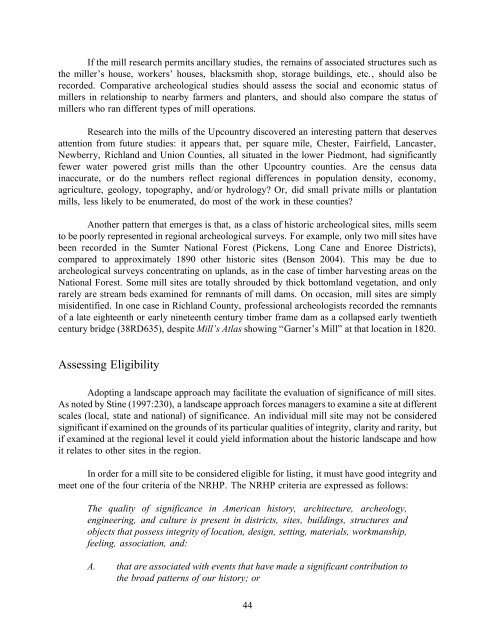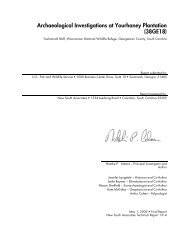Mills in the Upcountry: a Historic Context, and a Summary of a Mill ...
Mills in the Upcountry: a Historic Context, and a Summary of a Mill ...
Mills in the Upcountry: a Historic Context, and a Summary of a Mill ...
You also want an ePaper? Increase the reach of your titles
YUMPU automatically turns print PDFs into web optimized ePapers that Google loves.
If <strong>the</strong> mill research permits ancillary studies, <strong>the</strong> rema<strong>in</strong>s <strong>of</strong> associated structures such as<br />
<strong>the</strong> miller’s house, workers’ houses, blacksmith shop, storage build<strong>in</strong>gs, etc., should also be<br />
recorded. Comparative archeological studies should assess <strong>the</strong> social <strong>and</strong> economic status <strong>of</strong><br />
millers <strong>in</strong> relationship to nearby farmers <strong>and</strong> planters, <strong>and</strong> should also compare <strong>the</strong> status <strong>of</strong><br />
millers who ran different types <strong>of</strong> mill operations.<br />
Research <strong>in</strong>to <strong>the</strong> mills <strong>of</strong> <strong>the</strong> <strong>Upcountry</strong> discovered an <strong>in</strong>terest<strong>in</strong>g pattern that deserves<br />
attention from future studies: it appears that, per square mile, Chester, Fairfield, Lancaster,<br />
Newberry, Richl<strong>and</strong> <strong>and</strong> Union Counties, all situated <strong>in</strong> <strong>the</strong> lower Piedmont, had significantly<br />
fewer water powered grist mills than <strong>the</strong> o<strong>the</strong>r <strong>Upcountry</strong> counties. Are <strong>the</strong> census data<br />
<strong>in</strong>accurate, or do <strong>the</strong> numbers reflect regional differences <strong>in</strong> population density, economy,<br />
agriculture, geology, topography, <strong>and</strong>/or hydrology? Or, did small private mills or plantation<br />
mills, less likely to be enumerated, do most <strong>of</strong> <strong>the</strong> work <strong>in</strong> <strong>the</strong>se counties?<br />
Ano<strong>the</strong>r pattern that emerges is that, as a class <strong>of</strong> historic archeological sites, mills seem<br />
to be poorly represented <strong>in</strong> regional archeological surveys. For example, only two mill sites have<br />
been recorded <strong>in</strong> <strong>the</strong> Sumter National Forest (Pickens, Long Cane <strong>and</strong> Enoree Districts),<br />
compared to approximately 1890 o<strong>the</strong>r historic sites (Benson 2004). This may be due to<br />
archeological surveys concentrat<strong>in</strong>g on upl<strong>and</strong>s, as <strong>in</strong> <strong>the</strong> case <strong>of</strong> timber harvest<strong>in</strong>g areas on <strong>the</strong><br />
National Forest. Some mill sites are totally shrouded by thick bottoml<strong>and</strong> vegetation, <strong>and</strong> only<br />
rarely are stream beds exam<strong>in</strong>ed for remnants <strong>of</strong> mill dams. On occasion, mill sites are simply<br />
misidentified. In one case <strong>in</strong> Richl<strong>and</strong> County, pr<strong>of</strong>essional archeologists recorded <strong>the</strong> remnants<br />
<strong>of</strong> a late eighteenth or early n<strong>in</strong>eteenth century timber frame dam as a collapsed early twentieth<br />
century bridge (38RD635), despite <strong>Mill</strong>’s Atlas show<strong>in</strong>g “Garner’s <strong>Mill</strong>” at that location <strong>in</strong> 1820.<br />
Assess<strong>in</strong>g Eligibility<br />
Adopt<strong>in</strong>g a l<strong>and</strong>scape approach may facilitate <strong>the</strong> evaluation <strong>of</strong> significance <strong>of</strong> mill sites.<br />
As noted by St<strong>in</strong>e (1997:230), a l<strong>and</strong>scape approach forces managers to exam<strong>in</strong>e a site at different<br />
scales (local, state <strong>and</strong> national) <strong>of</strong> significance. An <strong>in</strong>dividual mill site may not be considered<br />
significant if exam<strong>in</strong>ed on <strong>the</strong> grounds <strong>of</strong> its particular qualities <strong>of</strong> <strong>in</strong>tegrity, clarity <strong>and</strong> rarity, but<br />
if exam<strong>in</strong>ed at <strong>the</strong> regional level it could yield <strong>in</strong>formation about <strong>the</strong> historic l<strong>and</strong>scape <strong>and</strong> how<br />
it relates to o<strong>the</strong>r sites <strong>in</strong> <strong>the</strong> region.<br />
In order for a mill site to be considered eligible for list<strong>in</strong>g, it must have good <strong>in</strong>tegrity <strong>and</strong><br />
meet one <strong>of</strong> <strong>the</strong> four criteria <strong>of</strong> <strong>the</strong> NRHP. The NRHP criteria are expressed as follows:<br />
The quality <strong>of</strong> significance <strong>in</strong> American history, architecture, archeology,<br />
eng<strong>in</strong>eer<strong>in</strong>g, <strong>and</strong> culture is present <strong>in</strong> districts, sites, build<strong>in</strong>gs, structures <strong>and</strong><br />
objects that possess <strong>in</strong>tegrity <strong>of</strong> location, design, sett<strong>in</strong>g, materials, workmanship,<br />
feel<strong>in</strong>g, association, <strong>and</strong>:<br />
A. that are associated with events that have made a significant contribution to<br />
<strong>the</strong> broad patterns <strong>of</strong> our history; or<br />
44







